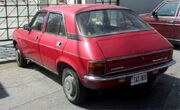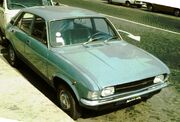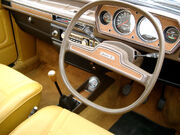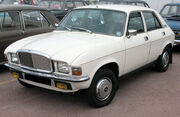| This article needs additional citations for verification. Please help improve this article by adding citations to reliable sources. Unsourced material may be challenged and removed. (March 2009) |
 | |
| Manufacturer | British Leyland Motor Corporation |
|---|---|
| Also called |
Vanden Plas 1500 [1] Vanden Plas 1.5 [1] Vanden Plas 1.7 [1] Innocenti Regent |
| Production | 1973–1983 |
| Assembly |
Longbridge Seneffe Milan |
| Predecessor | Austin 1100 |
| Successor | Austin Maestro |
| Class | Compact |
| Body style(s) |
2-door saloon 3-door estate 4-door saloon |
| Layout | FF layout |
| Engine(s) |
1.0 L A-Series I4 1.1 L A-Series I4 1.3 L A-Series I4 1.5 L E-Series I4 1.7 L E-Series I4 |
| Wheelbase | 2442 mm (96 in) |
| Length | 3852 mm (152 in) |
| Width | 1613 mm (63 in) |
| Height | 1398 mm (55 in) |
| Kerb weight | 869 kg (1915 lb) (approx) |
The Austin Allegro is a small family car manufactured by British Leyland under the Austin name from 1973 until 1983. The same vehicle was built in Italy by Innocenti between 1974 and 1975 and sold as the Innocenti Regent. In total, 642,350 Austin Allegros were produced during its ten-year production life, most of which were sold on the home market.
Design[]
The Allegro was designed as the replacement for the popular Austin 1100 and 1300 models, designed by Sir Alec Issigonis. As with the Morris Marina, the car can be seen with hindsight as symptomatic of the enormous difficulties facing British Leyland during that period. The key factor that British Leyland can now be seen to have missed is that a much more useful and popular form of car, the hatchback, was emerging in Europe, with designs such as the Autobianchi A112, Renault 16, and Volkswagen Golf. This configuration would go on to dominate the market for small family cars in the space of a few years. British Leyland stuck to the more traditional and less versatile booted design when they launched the Allegro. This was because of internal company politics; it had been decided that the Austin Maxi should have a hatchback as its unique selling point, and that no other car in the company's line-up was allowed one. This decision hamstrung both the Allegro and the Princess, both designs naturally suited to a hatchback yet not given one.[citation needed]

Rear of an exported Allegro
The Allegro used front-wheel drive, using the familiar A-Series engine with a sump-mounted transmission. The higher-specification models used the SOHC E-Series engine (from the Maxi), in 1500 cc and 1750 cc displacements. The two-box saloon bodyshell was suspended using the new Hydragas system (derived from the previous Hydrolastic system used on the 1100/1300).

The Allegro was assembled by Innocenti in Italy where it was badged as the Innocenti Regent.
Stylistically, it went against the sharp-edged styling cues that were becoming fashionable (largely led by Italian designer Giorgetto Giugiaro), and featured rounded panel work. The original styling proposal, by Harris Mann, had the same sleek, wedge-like shape of the Princess, but because British Leyland management, keen to control costs, wanted to install the existing E-Series engine and bulky heating system from the Marina, it became impossible to incorporate the low bonnet line as envisaged: the bodyshell began to look more and more bloated and tubby. This was acceptable to BL, however, which according to Jeff Daniels' book—British Leyland, The Truth About The Cars, published in 1980—wanted to follow the Citroën approach of combining advanced technology with styling that eschewed mainstream trends to create long-lasting "timeless" models. Its unfashionable shape was thus not a problem. The final car bore little resemblance to Mann's original concept that had originally been conceived as an 1100/1300 re-skin. This, as well as British Leyland's faith in it as a model that would help turn the company around, led to it earning the early nickname of the "flying pig". The car was offered in the usual range of British Leyland colours; notably beige, brown, and green.

Allegro buyers preferring a car with a tailgate had to opt for the estate (seen here in post-1979 facelift style).
With the Allegro, the makers avoided the full extent of badge engineering that defined the marketing of its predecessor, but they nevertheless introduced in September 1974[2] an upmarket Allegro branded as the Vanden Plas 1500/automatic: this featured a prominent grille at the front and an interior enhanced by a range of modifications designed to attract traditionally inclined customers, including special seats upholstered in real leather with reclining backrests, 'deep' carpets, extra sound insulation, a new instrument panel in walnut, nylon headlining and, for the luggage a fully trimmed boot / trunk. In 1974, a time when the UK starting price for the Austin Allegro was given as £1159, BLMC were quoting, at launch, a list price of £1951 for its Vanden Plas sibling.[2] The Allegro name was not used on this version.

Quartic Steering Wheel as featured in the Allegro at launch
Early Allegro models featured a "quartic" steering wheel, which was rectangular, with rounded sides. This was touted as allowing extra room between the driver's legs and the base of the steering wheel. The quartic wheel did not take off, and was first dropped in 1974 when the SS was replaced by the HL, the VP 1500 was never introduced with one, despite it being featured in the owners manual. Despite this feature only having appeared on certain models for a limited time, the Allegro has always been associated with the criticism that it "had a square steering wheel".
In April 1975 a 3-door estate car version was added to the range: Allegros were now coming off the production line with the same conventional steering wheel as the Morris Marina,[3] although the company waited till early June 1975 to announce, rather quietly, the demise of the Allegro's quartic steering wheel, presumably to give time for older cars to emerge from the sales and distribution network. Similar to the 2-door saloon the Allegro estates featured a rear wash wipe and coachline like the saloon models: the spare wheel was housed under the rear load floor area. They were only in production for approx 100 days before the arrival of the Series 2 model, making Series I Allegro estate rarer than most other models in the range.
There was a similar situation in New Zealand where the New Zealand Motor Corporation, which at the time had CKD kit assembly plants in Newmarket and Panmure, Auckland, and Petone, Wellington, began Allegro assembly in 1975 - with the circular steering wheel. Only a few hundred 'Mark Ones' - among the first locally built car models to have a factory-fitted heated rear window - were built before the 'Mark Two' was launched. Most Allegros sold in New Zealand had the 1300cc A-series OHV engine and four-speed manual gearbox. Later, the 1.5-litre OHC engine with four-speed automatic 'box was offered but this was eventually dropped. NZMC, moving away from UK sourced cars to models from its Honda franchise (it began Civic assembly in 1976 with the Accord following in 1978), later rationalised Allegro output to offering just two paint colours - metallic brown or solid dark blue - with a cream vinyl roof and brown interior trim. One batch of 48 'Mark Three' CKD kits was shipped from England after NZMC had decided to drop the Allegro in 1980 and these were assembled and sold - also in brown or cream; these rare cars have four round headlights rather than two square units and different tail lights plus a restyled dashboard.
Dimensions[]

Vanden Plas 1500 variant, 1977 model
- Overall length: 3852 mm (152 in)
- Overall width: 1613 mm (63 in)
- Height: 1398 mm (55 in)
- Wheelbase: 2442 mm (96 in)
- Track: 1346 mm (53 inches)
- Weight: 869 kg (1915 lb)
- Tyre size: 145 x 13 (155 x 13 on 1750 and Sport)
Range[]
| Types | Years | Body Style | Engine | Transmission |
|---|---|---|---|---|
| Allegro 1100 DL | 1973–1975 | 2-door Saloon 4-door Saloon |
1098 cc 48 bhp (36 kW) |
4-speed Manual |
| Allegro 1300 DL | 1973–1975 | 2-door Saloon 1973–74 4-door Saloon |
1275 cc 54 bhp (40 kW) |
4-speed Manual 4-speed Automatic |
| Allegro 1300 SDL | 1973–1975 1975 |
2-door Saloon 4-door Saloon 3-door Estate |
1275 cc 54 bhp (40 kW) |
4-speed Manual 4-speed Automatic |
| Allegro 1500 SDL | 1973–1975 1975 |
2-door Saloon 1973–74 4-door Saloon 3-door Estate |
1485 cc 68 bhp (51 kW) |
5-speed Manual 4-speed Automatic |
| Allegro 1500 Special | 1973–1975 | 4-door Saloon | 1485 cc 68 bhp (51 kW) |
5-speed Manual 4-speed Automatic |
| Allegro 1750 Sport | 1973–1974 | 2-door Saloon 4-door Saloon |
1748 cc 80 bhp (60 kW) |
5-speed Manual 4-speed Automatic |
| Allegro 1750 SS | 1973–1974 | 4-door Saloon | 1748 cc 80 bhp (60 kW) |
5-speed Manual 4-speed Automatic |
| Allegro 1750 HL | 1974–1975 | 4-door Saloon | 1748 cc 90 bhp (67 kW) |
5-speed Manual |
| Allegro 1750 Sport TC | 1974–1975 | 4-door Saloon | 1748 cc 90 bhp (67 kW) |
5-speed Manual |
| Vanden Plas 1500 [4] | 1974–1976 [4] | 4-door Saloon | 1485 cc 68 bhp (51 kW) |
5-speed Manual 4-speed Automatic |
Allegro 2 (1975–1979)[]
Launched in time for the London Motor Show in October 1975, the Allegro 2 had the same bodyshells but featured a new grille, reversing lights on most models and some interior changes to increase rear seat room. The Estate gained a new coachline running over the wing top lip and window edges. Changes were also made to the suspension, braking, engine mounts and drive shafts.

Austin Allegro 1300 (1979): the Allegro was also offered as a two door saloon
At the end of 1976 British Leyland confirmed that they were holding exploratory talks with trades union representatives concerning the possible transfer of Allegro production from Longbridge to the company's plant at Seneffe in Belgium.[5] The Belgian plant was already assembling the cars for continental European markets using CKD kits shipped from the UK.[5] The stated objective of the transfer was to free up capacity at Longbridge for the manufacture of the forthcoming ADO88 Mini replacement. In the event the ADO88 project was abandoned and the eventual Mini replacement, the less ambitiously engineered Austin Metro, did not reach the market place for another four years. Whether for reasons of politics or of customer demand or of cost at a time of rapid currency realignment, Allegros for the UK market continued to be manufactured in the UK; the Belgian plant was closed in the early 1980s, by which time Allegro demand in continental Europe had faltered and BLMC's Austin-Morris division clearly had more production capacity than product demand.
Some models of Allegro 2 made for non-UK markets were equipped with four round headlights, rather than the usual two rectangular items.
Range[]
| Types | Years | Body Style | Engine | Transmission |
|---|---|---|---|---|
| Allegro S2 1100 DL | 1975–1979 | 2-door Saloon 4-door Saloon |
1098 cc 48 bhp (36 kW) |
4-speed Manual |
| Allegro S2 1300 DL | 1975–1977 for fleet customers only |
2-door Saloon 4-door Saloon |
1275 cc 54 bhp (40 kW) |
4-speed Manual |
| Allegro S2 1300 Super | 1975–1979 | 2-door Saloon 4-door Saloon 3-door Estate |
1275 cc 54 bhp (40 kW) |
4-speed Manual 4-speed Automatic |
| Allegro S2 1500 Super | 1975–1979 | 4-door Saloon 3-door Estate |
1485 cc 68 bhp (51 kW) |
5-speed Manual 4-speed Automatic |
| Allegro S2 1500 Special | 1975–1979 | 4-door Saloon | 1485 cc 68 bhp (51 kW) |
5-speed Manual 4-speed Automatic |
| Allegro S2 1500 Special LE | 1978 Limited Edition | 4-door Saloon | 1485 cc 68 bhp (51 kW) |
5-speed Manual |
| Vanden Plas S2 1500 [6] | 1976–1979 [6] | 4-door Saloon | 1485 cc 68 bhp (51 kW) |
5-speed Manual 4-speed Automatic |
| Allegro S2 1750 HL | 1975–1979 | 4-door Saloon | 1748 cc 91 bhp (68 kW) |
5-speed Manual |
| Allegro S2 1750 Equipe | 1979 Limited Edition | 2-door Saloon | 1748 cc 91 bhp (68 kW) |
5-speed Manual |
Allegro 3 (1979–1983)[]
The Allegro 3, introduced at the end of 1979, used the "A-Plus" version of the 1.0 litre A-Series engine (developed for the forthcoming new Metro), and featured some cosmetic alterations in an attempt to keep the momentum going, but by then the Allegro was outdated, competing against the relatively high-tech Ford Escort Mark III and Vauxhall Astra, and after 1980 it failed to feature in the top 10 best selling new cars in Britain, barely a decade since its predecessor had been Britain's most popular new car, though this fall in sales was compensated for by the large sales figures achieved by the smaller Metro.
The Vanden Plas models were rebranded as the 1.5 and the 1.7.[7] The 1.5 having a twin carburettor 1500cc engine and a manual gear box while the 1.7 had a single carburettor 1750cc engine and an automatic gear box.
Some models of Allegro 3 (the early HL and later HLS models) were equipped with four round headlights, rather than the more usual two rectangular ones.
The Allegro was finally discontinued with the launch of the Austin Maestro on 1 March 1983.[8]
Range[]
| Types | Years | Body Style | Engine | Transmission |
|---|---|---|---|---|
| Allegro S3 1.1 | 1979–1981 | 2-door Saloon 4-door Saloon |
1098 cc 48 bhp (36 kW) |
4-speed Manual |
| Allegro S3 1.0 L | 1981–1982 | 2-door Saloon 4-door Saloon |
998 cc 45 bhp (34 kW) |
4-speed Manual |
| Allegro S3 1.3 | 1979–1981 | 2-door Saloon 4-door Saloon |
1275 cc 63 bhp (47 kW) |
4-speed Manual 3-speed Automatic |
| Allegro S3 1.3 L | 1979–1982 | 2-door Saloon 4-door Saloon 3-door Estate |
1275 cc 63 bhp (47 kW) |
4-speed Manual 3-speed Automatic |
| Allegro S3 1.3 HL | 1979–1982 | 4-door Saloon | 1275 cc 63 bhp (47 kW) |
4-speed Manual |
| Allegro S3 1.3 HLS | 1981–1982 | 4-door Saloon | 1275 cc 63 bhp (47 kW) |
4-speed Manual 3-speed Automatic |
| Allegro S3 1.5 | 1979–1981 | 4-door Saloon | 1485 cc 77 bhp (57 kW) |
5-speed Manual |
| Allegro S3 1.5 L | 1979–1981 | 4-door Saloon 3-door Estate |
1485 cc 77 bhp (57 kW) |
5-speed Manual |
| Allegro S3 1.5 HL | 1979–1982 | 4-door Saloon 3-door Estate |
1485 cc 7 bhp (5.2 kW) |
5-speed Manual |
| Allegro S3 1.5 HLS | 1981–1982 | 4-door Saloon | 1485 cc 77 bhp (57 kW) |
5-speed Manual |
| Allegro S3 1.7 L | 1979–1981 | 4-door Saloon 3-door Estate |
1748 cc 91 bhp (68 kW) |
3-speed Automatic |
| Allegro S3 1.7 HL | 1979–1982 | 4-door Saloon 3-door Estate |
1748 cc 91 bhp (68 kW) |
5-speed Manual |
| Allegro S3 1.7 HLS | 1981–1982 | 4-door Saloon | 1748 cc 91 bhp (68 kW) |
5-speed Manual |
| Vanden Plas 1.5 [7] | 1979–1980 [7] | 4-door Saloon | 1485 cc 77 bhp (57 kW) |
5-speed Manual |
| Vanden Plas 1.7 [7] | 1979–1980 [7] | 4-door Saloon | 1748 cc 91 bhp (68 kW) |
3-speed Automatic |
Reputation[]
The car was somewhat underdeveloped at the time of its launch, and a number of design flaws plagued the early models. Most of these were fixed in the Allegro 2 edition of the car, launched in 1975.
In spite of all of this bad press, the Allegro was still a very popular car. As late as 1979, six years after its launch, it was the fifth best selling new car in Britain, although sales were falling by the time it was replaced by the Maestro in March 1983. In certain overseas markets it is not uncommon to see Allegros still in daily use.
Sales in its final years were disappointing, and by 1981 it had fallen out of the top 10, as more buyers were choosing two newer BL products: the similar-sized and more viable Triumph Acclaim, and the smaller Austin Metro.
In a July 2008 poll conducted by The Sun, the Austin Allegro was named, "the worst British car ever made".[9]
In his book, Crap Cars, writer Richard Porter says "the only bit of the Allegro they got even vaguely right was the rust-proofing". The Allegro placed second worst in his list, beaten only by the VW Beetle.[10] Despite this, the Allegro picked up a reputation for rust problems during its life. This was probably due to association with many other cars of the period (both from BL and other manufacturers) which had poor rust proofing. An early edition of What Car? ran a feature on the then new Allegro, including an interview with staff at a BL dealership, who were asked if any problems occurred with the car in service. They replied that the car suffered from rust problems to its rear subframe. However, the staff thought they were being asked about the 1100/1300 car, which had been out of production for five years. Nonetheless, the magazine went on to report on the Allegro's non-existent rust problems, creating a serious image problem.
The poor reputation of the car, and the inefficient production and management techniques in British Leyland at the time at which it was produced, have meant that the Austin Allegro has become associated with waste, inefficiency and poor quality. In Clarkson's Car Years Jeremy Clarkson compares the Austin Allegro to the Morris Marina. He concludes the Allegro is a better (less worse) car than the Marina, because the Allegro is a horrible car in a more original way than the Marina. In 2007, Sir Digby Jones, in criticising the inefficiencies of the Learning and Skills Council, said, "It is what I call the British Leyland model – you put a lot of money in at the top, and an Austin Allegro comes out at the bottom".[11]
In February 2006 it was reported that more than 1,000 Allegros sold in Britain were still registered with the DVLA,[12] a better survival rate than the more popular Morris Marina, most of which were dismantled for parts that were interchangeable with other British Leyland cars such as the MGB and Morris Minor.
Engines[]
- 1973–75: 1098 cc A-Series Straight-4, 49 bhp (37 kW) at 5250 rpm and 60 lb·ft (81 N·m) at 2450 rpm
- 1975–80: 1098 cc A-Series Straight-4, 45 bhp (34 kW) at 5250 rpm and 55 lb·ft (75 N·m) at 2900 rpm
- 1973–80: 1275 cc A-Series Straight-4, 59 bhp (44 kW) at 5300 rpm and 69 lb·ft (94 N·m) at 3000 rpm
- 1980–82: 998 A+ cc A-Plus Straight-4, 44 bhp (33 kW) at 5250 rpm and 52 lb·ft (71 N·m) at 3000 rpm
- 1980–82: 1275 cc A-Plus Straight-4, 62 bhp (46 kW) at 5600 rpm and 72 lb·ft (98 N·m) at 3200 rpm
- 1973–82: 1485 cc E-Series Straight-4, 69 bhp (51 kW) at 5600 rpm and 83 lb·ft (113 N·m) at 3200 rpm
- 1973–82: 1748 cc E-Series Straight-4, 76 bhp (56 kW) at 5000 rpm and 104 lb·ft (141 N·m) at 3100 rpm
- 1974–?: 1748 cc E-Series twin-carburetted Straight-4, 90 bhp (67 kW) at 5000 rpm and 104 lb·ft (141 N·m) at 3100 rpm
References[]
- ↑ 1.0 1.1 1.2 The Vanden Plas Owners Club Retrieved on 18 February 2013
- ↑ 2.0 2.1 "Vanden Plas 1500: A new luxury model from British Leyland based on the 1,485 cc Austin Allegro 1500 with special trimming and finish by Vanden Plas", Autocar 141 (nbr4065): pages 26–28. 21 September 1974.
- ↑ "News: Allegros - quartic wheel abandoned", Autocar 141 (nbr 4100): page 25. date 7 June 1975.
- ↑ 4.0 4.1 Vanden Plas 1500 Series 1 1974-76 UK Brochure Retrieved on 18 February 2013
- ↑ 5.0 5.1 "News: Allegro for Belgium?", Autocar 145 (nbr 4178): page 26. date 4 December 1976.
- ↑ 6.0 6.1 Vanden Plas 1500 Series 2 1976-79 UK Market Sales Brochure Retrieved on 18 February 2013
- ↑ 7.0 7.1 7.2 7.3 7.4 Vanden Plas 1.5 & 1.7 Series 3 1979-80 UK Market Sales Brochure Retrieved on 18 February 2013
- ↑ "The best of the British car industry". AROnline. Retrieved on 2012-04-08.
- ↑ Ken Gibson (17 July 2008). "Austin's Allegro 'worst car ever'", The Sun. Retrieved on 13 September 2010.
- ↑ BBC (2004-10-13). "The crappest car in Britain – named and shamed in Crap Cars", http://web.archive.org/web/20070329161525/http://www.bbc.co.uk/pressoffice/bbcworldwide/worldwidestories/pressreleases/2004/10_october/crap_cars.shtml. Retrieved on .
- ↑ "Can we fix the skills shortage?", BBC (2007-02-20). Retrieved on 2008-03-07.
- ↑ The Observer newspaper
- Adams, Keith. "The Unofficial Austin Rover Web Resource".
External links[]
| |||||||||||||||||||||||||||||||||||||||||||||||||||||
| This page uses some content from Wikipedia. The original article was at Austin Allegro. The list of authors can be seen in the page history. As with Tractor & Construction Plant Wiki, the text of Wikipedia is available under the Creative Commons by Attribution License and/or GNU Free Documentation License. Please check page history for when the original article was copied to Wikia |